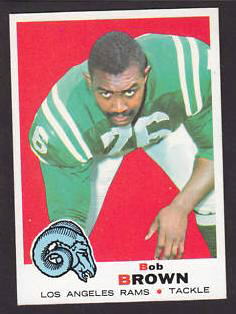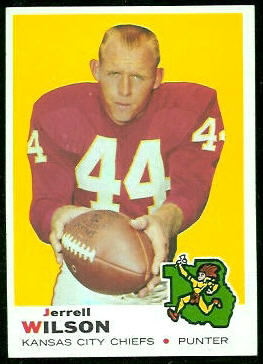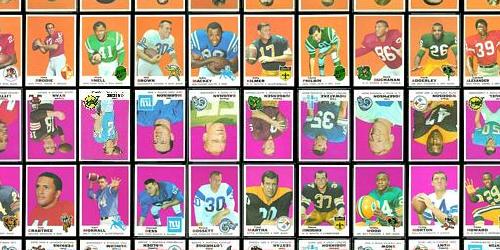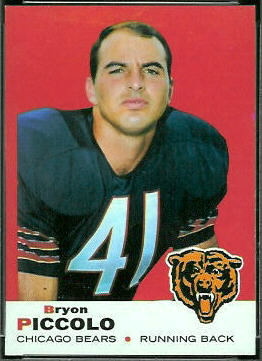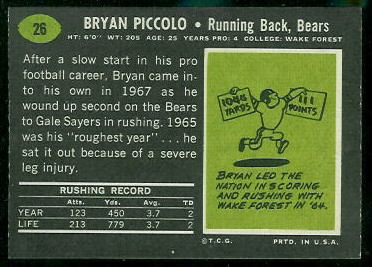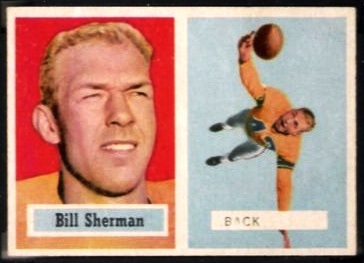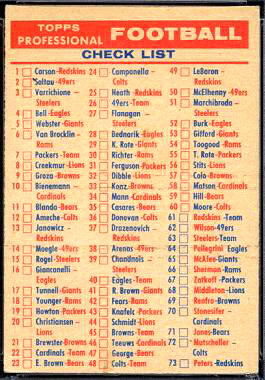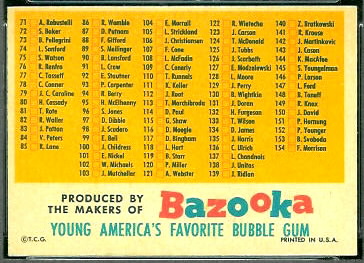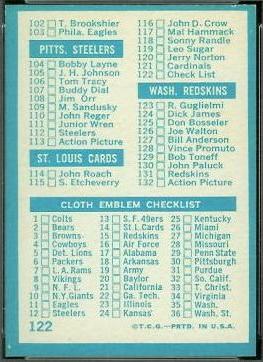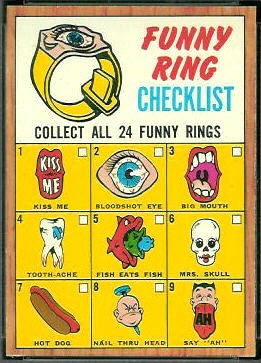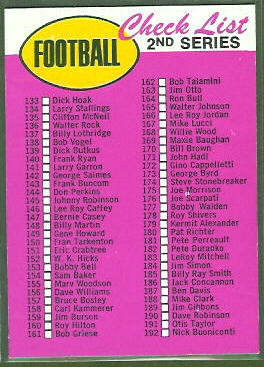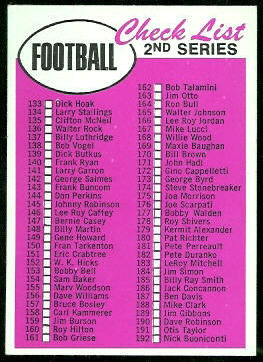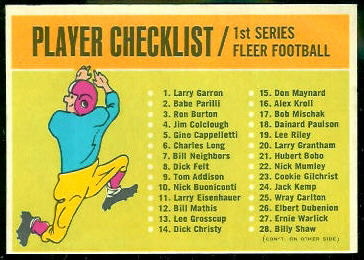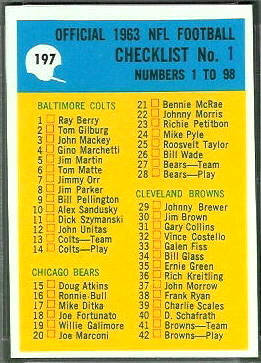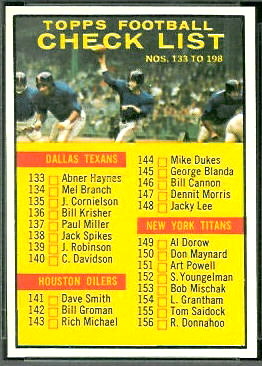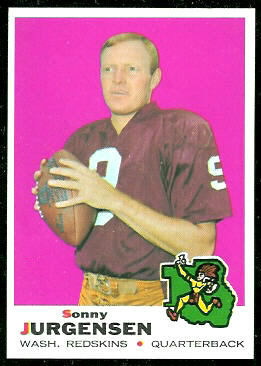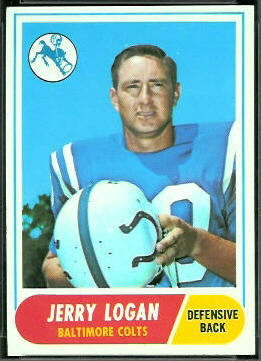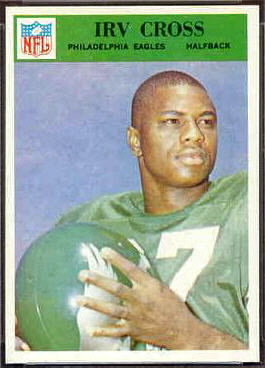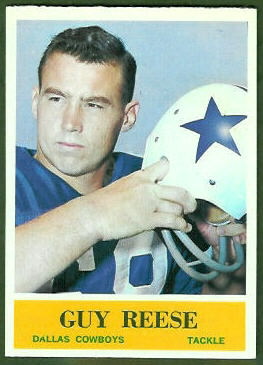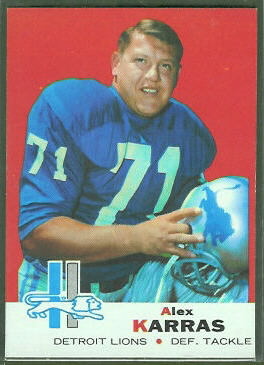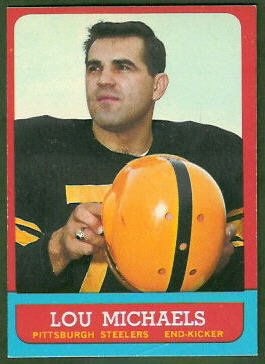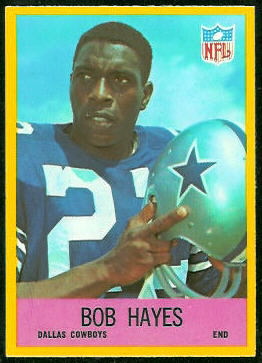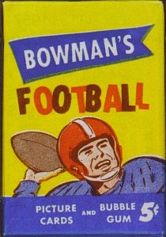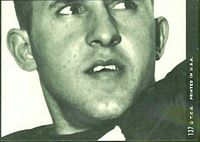S is for Scratch-Offs
January 9th, 2010 | Published in ABCs of Vintage Football Cards
In the 1950s and 1960s, when the card companies were still marketing to kids, they tried to make the cards interactive and fun to play with. They made cards you could punch out and stand up, they put puzzles on the backs of the cards, and they inserted stamps, stickers, and decals into the packs with the regular cards. They also liked to put scratch-off cartoons and quizzes on the card backs.
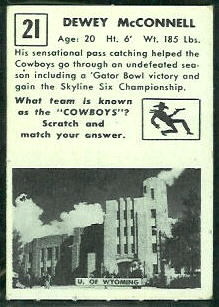
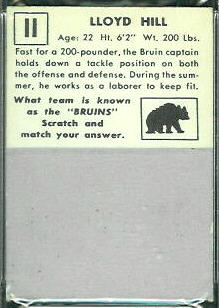 1951 Topps Magic cards were the first football cards with scratch-off backs, the scratch-offs accounting for the “magic” in the name. The material Topps used for the scratch-offs was similar to that used on today’s lottery tickets: a silver-gray coating that crumbled off when you scratched it. Scratching off the crumbly coating revealed a picture of the player’s school, along with the school’s name. The feature apparently was a hit, because most 1951 Topps cards I see have been scratched.
1951 Topps Magic cards were the first football cards with scratch-off backs, the scratch-offs accounting for the “magic” in the name. The material Topps used for the scratch-offs was similar to that used on today’s lottery tickets: a silver-gray coating that crumbled off when you scratched it. Scratching off the crumbly coating revealed a picture of the player’s school, along with the school’s name. The feature apparently was a hit, because most 1951 Topps cards I see have been scratched.
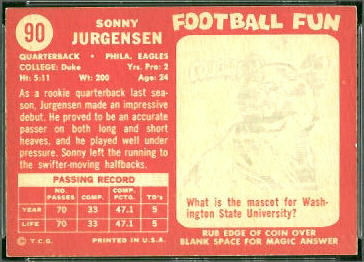 The next football cards with scratch-off backs were 1958 Topps cards. Topps used a different material this time, a white substance that revealed a gray picture when rubbed, but that didn’t come off of the card. All of the player cards in the set had scratch-off backs, but, as shown on this Sonny Jurgensen rookie card, the questions and answers were not about the players on the cards. Even now, I’m disappointed.
The next football cards with scratch-off backs were 1958 Topps cards. Topps used a different material this time, a white substance that revealed a gray picture when rubbed, but that didn’t come off of the card. All of the player cards in the set had scratch-off backs, but, as shown on this Sonny Jurgensen rookie card, the questions and answers were not about the players on the cards. Even now, I’m disappointed.
Unlike the 1951 Topps cards, most of the 1958 Topps cards I see have not been rubbed. Perhaps it’s because the pictures were not as clear as on the 1951 cards. Or perhaps scraping the little silver-gray pellets onto the floor had been part of the fun. For whatever reason, after 1951, the magic was gone.
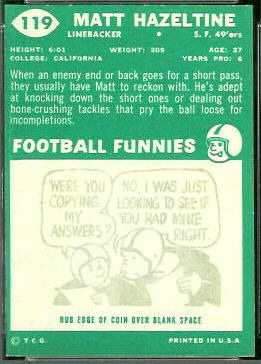
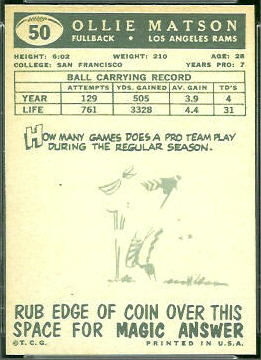 The scratch-offs on 1959 Topps football cards were also unrelated to the player, but they differed a bit from 1958. Part of the picture on each card was visible before rubbing, and you rubbed the card to reveal the rest. Maybe Topps exposed part of the picture to entice kids to rub the card, but I don’t see many 1959 Topps cards that are rubbed, either. To my knowledge, this was the only set in which parts of the pictures were already showing.
The scratch-offs on 1959 Topps football cards were also unrelated to the player, but they differed a bit from 1958. Part of the picture on each card was visible before rubbing, and you rubbed the card to reveal the rest. Maybe Topps exposed part of the picture to entice kids to rub the card, but I don’t see many 1959 Topps cards that are rubbed, either. To my knowledge, this was the only set in which parts of the pictures were already showing.
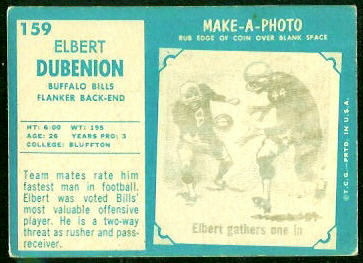 The backs of player cards in the 1960 Topps football set also had scratch-offs, but this time there were no questions and answers, just “Football Funnies” cartoons. I have just one rubbed card, the Matt Hazeltine card pictured here, and the cartoon on it isn’t even related to football. I know they were selling to kids, but I think Topps should have just printed the players’ stats, instead.
The backs of player cards in the 1960 Topps football set also had scratch-offs, but this time there were no questions and answers, just “Football Funnies” cartoons. I have just one rubbed card, the Matt Hazeltine card pictured here, and the cartoon on it isn’t even related to football. I know they were selling to kids, but I think Topps should have just printed the players’ stats, instead.
Topps persisted with the scratch-offs in 1961. Rubbing the back of a 1961 Topps card revealed a generic cartoon of a player in action, labeled with the name of the player on the card. Though the cartoons were generic, Topps at least took care to get the players’ numbers right. Elbert Dubenion, whose card is shown here, indeed wore number 44.
After 1961, Topps took a break from scratch-offs, instead simply printing cartoons on the card backs. The Philadelphia Gum Company picked up the slack, using the scratch-off feature on their cards in 1965 and 1967. Scratching a 1965 Philadelphia card revealed a picture of one player, and the name of another. To find the name of the pictured player, the card back directed you to a different card, which had the answer. This was a bit convoluted for a kid, I’d say. Philadelphia dispensed with the scratch-offs in 1966, but retained the picture-on-one-card, name-on-another quiz.
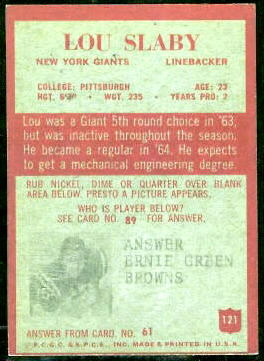
 In 1967, Philadelphia again put scratch-offs on their cards, but this time they used simple questions and answers related to the player on the card. I don’t know how well the scratch-offs worked back then, but I recently rubbed the Dale Hackbart card shown here, and I can barely see the answer. (It’s “He teaches school.”)
In 1967, Philadelphia again put scratch-offs on their cards, but this time they used simple questions and answers related to the player on the card. I don’t know how well the scratch-offs worked back then, but I recently rubbed the Dale Hackbart card shown here, and I can barely see the answer. (It’s “He teaches school.”)
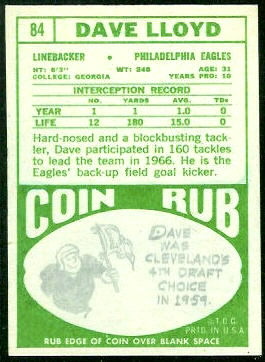 Topps returned to scratch-offs in 1968, but they didn’t put them on every card. Only about 20% of the cards have the “Coin Rub” on the back, and the other 80% have cartoons about the players printed on them. I imagine that limiting the number of scratch-offs was a cost saving measure: someone at Topps wanted the scratch-offs, and someone else said “Why? The kids don’t scratch them, anyway.” And so they compromised. Rubbing the Coin Rub backs reveals cartoons like those on the other cards.
Topps returned to scratch-offs in 1968, but they didn’t put them on every card. Only about 20% of the cards have the “Coin Rub” on the back, and the other 80% have cartoons about the players printed on them. I imagine that limiting the number of scratch-offs was a cost saving measure: someone at Topps wanted the scratch-offs, and someone else said “Why? The kids don’t scratch them, anyway.” And so they compromised. Rubbing the Coin Rub backs reveals cartoons like those on the other cards.
Cards with Coin Rub backs appear in both series of 1968 Topps cards. I thought that Topps might have arranged the Coin Rub cards in a pattern on the uncut sheets–perhaps all in the same row or column, for instance–but they appear to have scattered them randomly on the sheets.
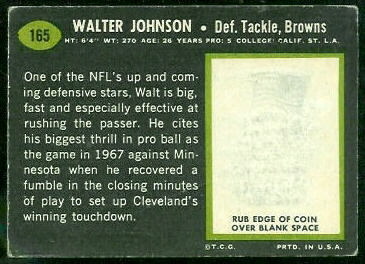
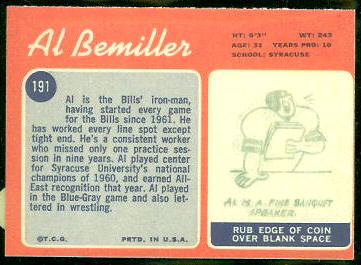 In 1969 and 1970, Topps again put scratch-offs on only a small number of cards. As in 1968, the scratch-offs revealed cartoons about the players, like those on the other cards. In 1969 and 1970, though, the scratch-offs appeared only in the second series of each set. Perhaps this was an effort to boost interest in the second series, after kids had burned themselves out trying to complete the first series. To my knowledge, 1970 Topps is the last set containing cards with scratch-off backs.
In 1969 and 1970, Topps again put scratch-offs on only a small number of cards. As in 1968, the scratch-offs revealed cartoons about the players, like those on the other cards. In 1969 and 1970, though, the scratch-offs appeared only in the second series of each set. Perhaps this was an effort to boost interest in the second series, after kids had burned themselves out trying to complete the first series. To my knowledge, 1970 Topps is the last set containing cards with scratch-off backs.
Considering how few scratch-offs actually got scratched after 1951, I am surprised that Topps put them on cards for as long as they did. Maybe they assumed that kids were busy scratching them, and didn’t know otherwise until years later, when old cards started coming out of attics. Collectors today don’t appreciate the scratch-offs, either: customers often ask me whether the backs of cards I am selling have been scratched.
I am also surprised, considering collectors’ aversion to scratched cards, that PSA is not harsher when grading them. I often see PSA 7s that have been rubbed, and the 1958 Topps Sonny Jurgensen card above is a PSA 8 OC. To me, a rubbed card ought to grade excellent at best, since an exposed cartoon is certainly more distracting than, say, a quarter-inch hairline crease. What do you think?
- Previous: R is for Rookie Cards
- Next: T is for Topps, Part 1: the 1950s
- All of the ABCs
